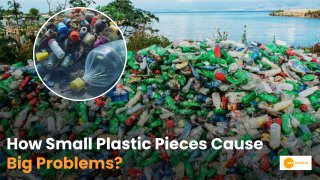Plastic pollution has become a growing concern, and one unsuspecting contributor to this issue is the tiny edge we cut off milk packets every day. Despite its small size, this piece of plastic poses significant threats to the environment and human health. Let’s delve into why this happens and what we can do to address it.
Why Milk Packet Edges Cannot Be Recycled?
Milk packets are made of low-density polyethylene (LDPE), a type of plastic that requires high temperatures and specific conditions to be recycled. Small pieces, such as the triangular edges of milk packets, are too insignificant in size to be processed effectively. They fail to compress into the required shapes and add no value during recycling.
When these small plastic tips are not recycled, they disintegrate into microplastics, tiny particles comparable in size to the microbeads found in personal care products like toothpaste and face washes. These microplastics are carried by rain and wind into water bodies and landfills, causing severe environmental damage. The Hazards of Tiny Plastic Pieces. The small edges of milk packets, though seemingly harmless, have a wide-reaching impact,
Micro plastics in the Ecosystem
- These plastic particles enter water bodies, where marine animals mistakenly consume them, leading to severe health issues and even death.
- Once in the food chain, microplastics also pose risks to human health.
Clogging and Pollution
- The triangular edges often end up in landfills, obstructing water flow and contributing to waste accumulation.
- During summer, the burning of these plastics releases toxic gases like furans and dioxins, known to cause cancer and respiratory diseases.
Plastic Waste Crisis
Dairy product packaging is a major contributor to household plastic waste, with milk packets alone accounting for a significant portion. Eco-Friendly Alternatives, Simple Changes for a Cleaner Future
- To reduce the environmental impact of milk packet edges, here are a few simple steps you can adopt,
- Instead of snipping off the triangular corner, make a horizontal cut to open the packet.
- If you must cut the edge, place it inside the larger milk packet before discarding it. This prevents loose pieces from entering the environment.
- Educate others about the consequences of cutting milk packet edges and encourage eco-friendly habits.
A Call to Action
Small actions lead to big changes. By adopting sustainable practices, we can minimize the harmful impact of plastic waste on the environment. It’s time to rethink our daily habits and take a step towards a cleaner, healthier planet. Let’s start by cutting down on the tiny edges!


